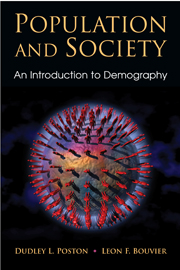Book contents
- Frontmatter
- Contents
- Preface
- Introduction
- 1 “We Are All Population Actors”: An Introduction to Demography
- 2 The Sources of Demographic Information
- 3 Fertility
- 4 Contraception and Birth Control
- 5 Mortality
- 6 Internal Migration
- 7 International Migration
- 8 Age and Sex Composition
- 9 World Population Change over Time
- 10 Population Change in the United States
- 11 Population Distribution
- 12 Cultural Adaptation and Growth
- 13 Population Policy
- 14 The Future of Planet Earth
- Glossary
- References
- Author Index
- Subject Index
2 - The Sources of Demographic Information
- Frontmatter
- Contents
- Preface
- Introduction
- 1 “We Are All Population Actors”: An Introduction to Demography
- 2 The Sources of Demographic Information
- 3 Fertility
- 4 Contraception and Birth Control
- 5 Mortality
- 6 Internal Migration
- 7 International Migration
- 8 Age and Sex Composition
- 9 World Population Change over Time
- 10 Population Change in the United States
- 11 Population Distribution
- 12 Cultural Adaptation and Growth
- 13 Population Policy
- 14 The Future of Planet Earth
- Glossary
- References
- Author Index
- Subject Index
Summary
INTRODUCTION
We noted toward the end of Chapter 1 that we demographers are more fortunate than many of our social science colleagues who must gather and develop their own databases. Generally speaking, most of the data we use have already been gathered for us, but not always. Indeed, some demographers do gather their own data, especially those who use anthropological perspectives and who engage in ethnographic research (Greenhalgh, 1990b, 1994; Riley, 1998; Riley and McCarthy, 2003). However, most of us use data already gathered and developed by other organizations. This chapter discusses the basic sources of demographic information, of which there are three.
The basic sources of demographic data are national censuses, registers, and surveys. National censuses and registers differ in that the former are conducted on a decennial (or, in some countries, quinquennial) basis, while the latter, theoretically at least, are compiled continuously. Actually, registration data of population events are usually compiled and published annually or monthly, but they are gathered continuously. A census may be likened to taking a snapshot of a population at one point in time, say, once every ten years, and in this snapshot getting a picture of the size of the population, its characteristics, and its spatial distribution. Conversely, a register may be thought of as a continuous compilation of major population events, often births, deaths, marriages, divorces, and sometimes migrations. As a birth or a death occurs, it is registered with the government; the registrations thus occur continuously.
- Type
- Chapter
- Information
- Population and SocietyAn Introduction to Demography, pp. 15 - 38Publisher: Cambridge University PressPrint publication year: 2010

